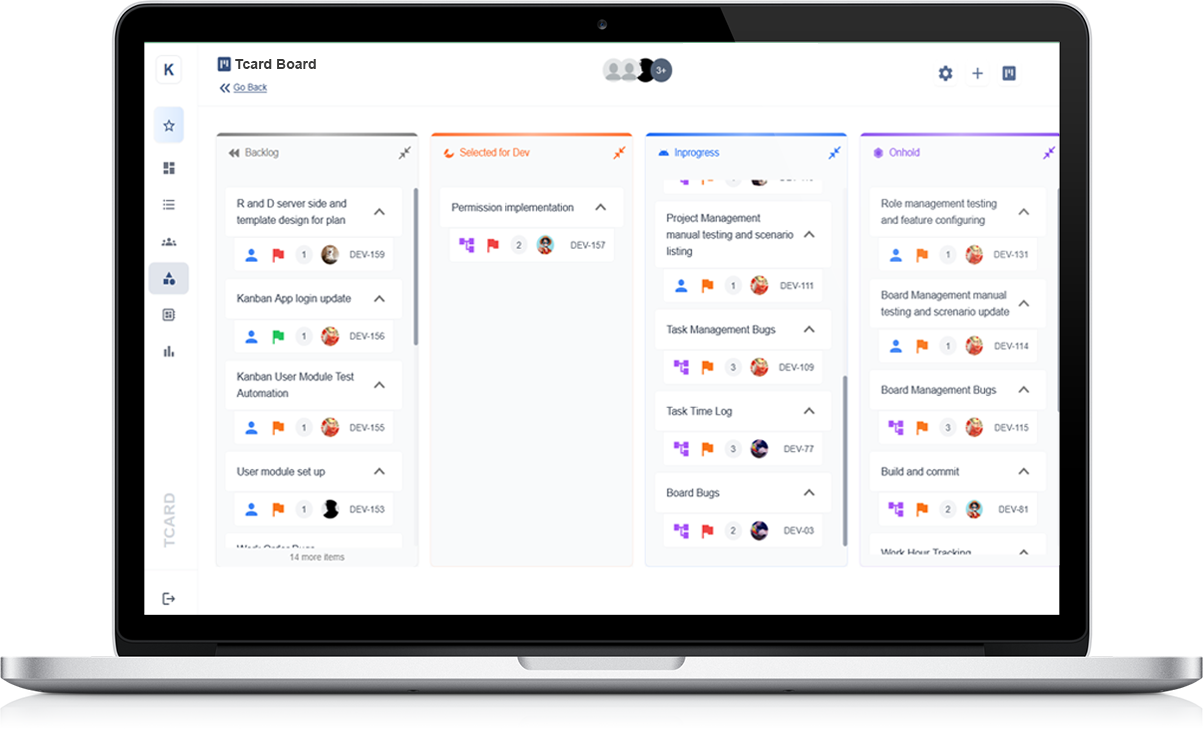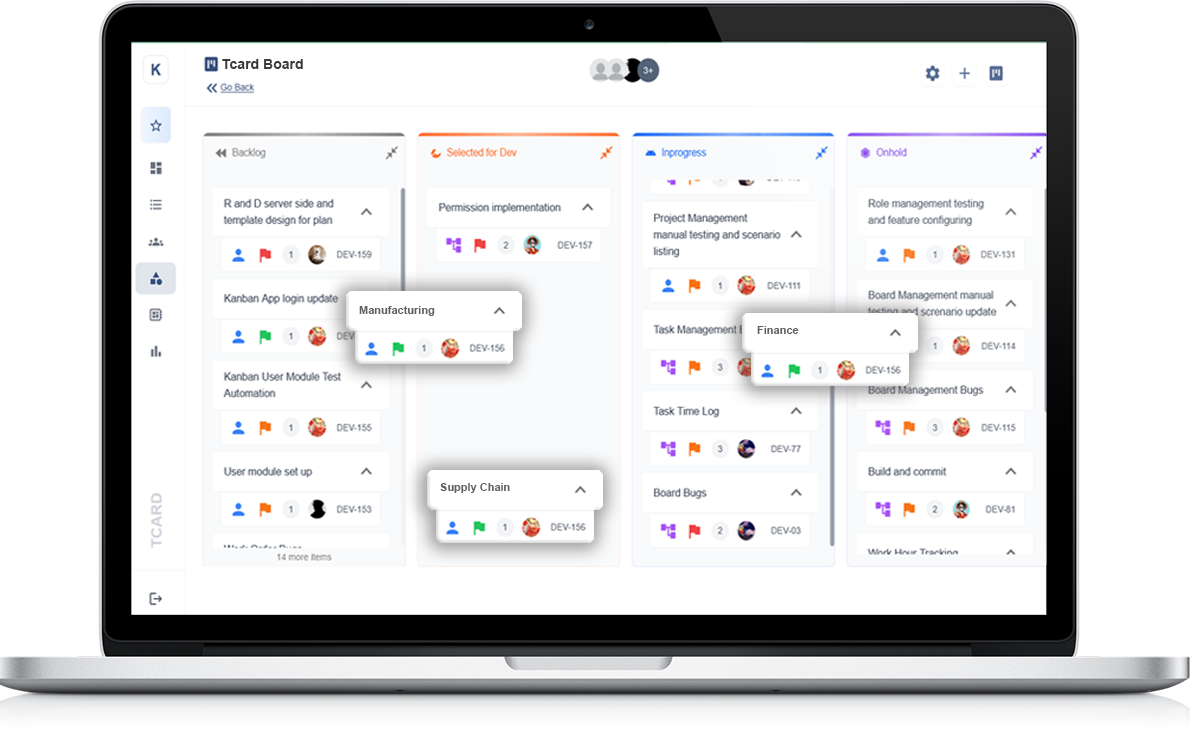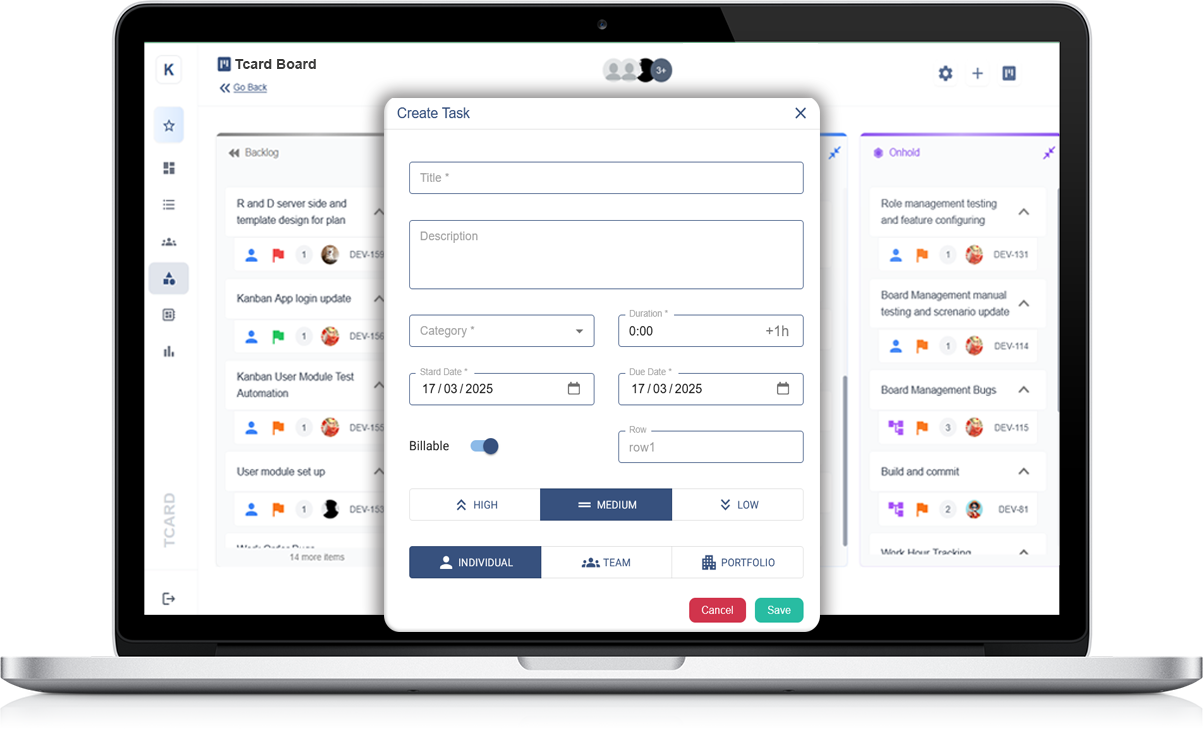What is the T Card System?

The T Card System is a simple and effective way to track tasks and manage workflows. It uses T-shaped cards placed on a board with labeled sections to show the progress of each task. As work moves forward, the cards are shifted to different sections, making it easy to see what is pending, in progress, or completed.
This system helps teams stay organised, reduce delays, and improve efficiency. It provides a clear visual overview, ensuring that all tasks are tracked properly. The T Card System is easy to use and does not require advanced tools or technology.
It is widely used in different workplaces to monitor daily activities, assign responsibilities, and keep work flowing smoothly. By offering a clear and structured way to manage tasks, the T Card System helps teams stay productive and complete work on time.
What are the types of T Card Systems?
The T Card System comes in different types, each designed to help manage tasks, track progress, and improve organisation. These systems are widely used in workplaces to monitor workflows and ensure smooth operations.
Manual T Card System
This traditional system uses physical T-shaped cards placed on a board with labeled sections. Each card represents a task and moves from one section to another as work progresses. It is simple, easy to use, and does not require technology.

Digital T Card System
This type works on a computer or device, offering the same task-tracking benefits as the manual system but with added features. It allows users to update tasks, assign work, and track progress in real time, making it ideal for teams working remotely.
Custom T Card System
Some workplaces design their own T Card Systems to match specific needs. These systems may include extra sections, color-coded cards, or unique labels to improve efficiency and task management.
Each type of T Card System helps teams stay organised, track progress, and complete work on time, making it a valuable tool for improving productivity.
What is the T Card Method?
The T Card Method is a simple and effective way to manage tasks, track work progress, and improve organisation. It provides a clear visual system that helps teams stay on top of their work and ensures tasks are completed on time.
How the T Card Method Works
This method uses T-shaped cards placed on a board with different sections. Each card represents a task, and as work progresses, the card is moved through the sections. Common sections include "To Do," "In Progress," and "Completed." This movement gives a quick and clear overview of all ongoing tasks.
Benefits of the T Card Method
- Easy Task Tracking: Provides a visual way to monitor work progress.
- Better Organisation: Helps manage tasks efficiently and reduces confusion.
- Quick Updates: Tasks can be adjusted instantly as work moves forward.
- Improves Productivity: Ensures teams stay focused and complete work on time.
The T Card Method is widely used in different workplaces for managing workflows, improving communication, and keeping work organised. Its simplicity and effectiveness make it a valuable tool for better task management.
T Card Systems Explained
What Is a T Card System?
A T Card system is a simple and effective tool for tracking tasks, schedules, and workflows. It uses cards shaped like a "T" that fit into a board, allowing teams to organise and monitor work visually.

How Does a T Card System Work?
Each T Card represents a task, job, or process. The board is divided into sections, such as "To Do," "In Progress," and "Completed." As work progresses, the cards move across the board, providing a clear visual update on task status.
Key Benefits of T Card Systems
Using a T Card system improves organisation and efficiency. It helps teams identify bottlenecks, track workloads, and ensure tasks are completed on time. The simplicity of the system makes it easy for anyone to use.
Where Are T Card Systems Used?
These systems are widely used in manufacturing, maintenance, logistics, and project management. They help businesses streamline operations by offering a clear and structured way to manage tasks.
Digital vs. Physical T Card Systems
Traditional T Card systems use physical boards and cards, while digital versions provide automated tracking and reporting. Both options offer visibility into work progress and improve team coordination.
Why Use a T Card System?
A T Card system keeps work organised, reduces errors, and enhances productivity. It provides a visual workflow that helps teams stay on track and meet deadlines efficiently.
What are T Cards used for?
T Cards are used to track tasks, manage workflows, and improve organisation. They provide a clear and simple way to monitor work progress, ensuring tasks are completed on time. These cards are placed on a board with different sections, and they are moved as work progresses.
Task Management
T Cards help organise daily tasks by providing a visual way to track progress. Each card represents a task, and it moves through different stages, such as "To Do," "In Progress," and "Completed."
Work Scheduling
They are used to plan work schedules by assigning tasks to specific time slots. This helps in balancing workloads and ensuring all tasks are completed within deadlines.
Progress Tracking
T Cards make it easy to track ongoing work. They help teams see which tasks need attention and prevent delays.
Improving Efficiency
By using T Cards, teams can stay organised, reduce confusion, and improve overall productivity. They provide a clear structure that helps in smooth workflow management.
T Cards are widely used in workplaces to keep work structured and ensure smooth operations.
T Card Systems in Manufacturing Environment
The T Card System is an effective tool used in manufacturing to track tasks, manage production processes, and improve workflow efficiency. It provides a clear visual representation of work progress, helping teams stay organised and ensuring smooth operations.
Production Planning
In manufacturing, T Cards are used to plan and schedule production activities. Each card represents a specific task, order, or process, and it moves through different sections such as "Scheduled," "In Progress," and "Completed." This helps in tracking the status of each job and prevents delays.
Workforce Management
The system helps in assigning tasks to workers and monitoring their progress. By using T Cards, managers can ensure that each task is completed on time and that workloads are balanced efficiently across the team.
Inventory Control
T Cards are used to track raw materials, tools, and finished products. When supplies are low, a card can signal the need for restocking, preventing shortages and production stoppages.
Equipment Maintenance
Regular maintenance is essential in manufacturing. T Cards help schedule maintenance tasks, track completed work, and ensure that machines are serviced on time, reducing downtime and improving productivity.
By using the T Card System in a manufacturing environment, businesses can streamline operations, reduce errors, and improve efficiency. It provides a simple yet powerful way to manage production processes and keep work organised.
How the T Card System Works
The T Card System is a simple and effective method for managing tasks, tracking progress, and improving workflow. It provides a clear visual structure that helps teams stay organised and ensures that work is completed efficiently. The system is widely used in different industries to manage daily operations, schedule tasks, and monitor ongoing processes.
Basic Structure of the T Card System
The T Card System consists of a board divided into different sections and T-shaped cards that represent tasks or work items. The board is typically labeled with sections such as "To Do," "In Progress," and "Completed." Each card contains details about a specific task, including descriptions, deadlines, and assigned responsibilities.
Placing and Moving T Cards
Tasks are written on T Cards and placed in the appropriate section of the board. As work progresses, the cards are moved from one section to another. For example, when a task is started, its card moves from "To Do" to "In Progress," and once finished, it is placed in the "Completed" section. This movement provides a clear visual representation of task progress.
Tracking and Managing Tasks
The T Card System makes it easy to track tasks at a glance. It helps teams quickly see what needs to be done, which tasks are in progress, and what has been completed. It also allows managers to identify bottlenecks, assign work efficiently, and ensure deadlines are met.
Benefits of the T Card System
- Better Organisation: Helps in structuring tasks and improving workflow.
- Easy Task Monitoring: Provides a clear visual overview of task status.
- Quick Updates: Tasks can be moved instantly as progress is made.
- Improved Efficiency: Reduces delays and ensures smooth operations.
The T Card System is a valuable tool for managing work efficiently. Its simplicity, ease of use, and ability to track tasks visually make it an excellent choice for improving productivity and workflow management.
Versatility of T Card Systems: Implementations across Diverse Industries
The T Card System is a flexible and efficient tool used in various industries to track tasks, manage workflows, and improve efficiency. Its simple visual format makes it easy to adapt to different work environments, ensuring smooth operations and better task management.
Manufacturing Industry
In manufacturing, T Card Systems help track production schedules, monitor inventory, and ensure timely equipment maintenance. Each card represents a task, such as machine servicing or material restocking, making it easy to keep production lines running smoothly.
Healthcare Sector
Hospitals and clinics use T Cards to manage patient appointments, track medical supplies, and schedule staff shifts. This system helps healthcare providers ensure timely patient care and maintain an organised workflow.
Logistics and Supply Chain
T Card Systems assist in tracking shipments, managing warehouse inventory, and scheduling deliveries. By visually organising transport schedules, businesses can reduce delays and improve overall supply chain efficiency.
Construction Industry
Construction companies use T Cards to assign tasks, monitor project timelines, and track worker availability. The system ensures that each phase of a project is completed on time, avoiding delays and mismanagement.
Office and Administration
Offices implement T Card Systems to manage workflow, schedule meetings, and track document processing. This method ensures that tasks are completed efficiently and that important deadlines are met.
Education Sector
Schools and universities use T Cards to organise lesson plans, track student progress, and schedule examinations. The system helps maintain a structured learning environment and ensures smooth academic operations.
The T Card System is a valuable tool for improving task management across different industries. Its versatility, ease of use, and ability to provide a clear visual overview make it a highly effective method for organising workflows and increasing productivity.
Digital T Cards Board
A Digital T Cards Board is an advanced version of the traditional T Card System, designed to improve task management and workflow tracking. It allows teams to organise tasks, monitor progress, and update work status in real time using an online platform.
How a Digital T Cards Board Works
Just like a physical board, a digital version displays tasks in different sections such as "To Do," "In Progress," and "Completed." Each task is represented by a digital T Card, which contains details like task descriptions, deadlines, and assigned team members. As work progresses, the cards are moved across sections to reflect the current status.
Benefits of Using a Digital T Cards Board
- Real-Time Updates: Teams can track tasks instantly from any location.
- Improved Collaboration: Multiple users can access and update the board at the same time.
- Better Organisation: Tasks are structured clearly, reducing confusion.
- Increased Efficiency: Helps teams stay on schedule and complete work faster.
A Digital T Cards Board is a powerful tool for businesses looking to streamline work processes, improve productivity, and ensure seamless task tracking.
Greater Insights into Your Operations
Understanding your operations is essential for improving efficiency, reducing delays, and maximising productivity. A well-organised system helps track tasks, monitor progress, and identify areas for improvement. By gaining deeper insights into daily workflows, businesses can make better decisions and streamline processes.
Tracking Task Progress
One of the key benefits of better operational insights is the ability to track task progress in real time. By using a structured system, teams can see which tasks are pending, in progress, or completed. This visibility ensures work is completed on schedule and prevents delays.
Identifying Bottlenecks
By analysing workflows, businesses can identify bottlenecks that slow down operations. Whether it's a delay in approvals, material shortages, or inefficient processes, pinpointing these issues allows for quick resolutions and smoother workflows.
Improving Resource Allocation
Efficient operations require proper resource management. Gaining insights into workload distribution helps assign tasks effectively, preventing overburdened teams and improving productivity.
Enhancing Decision-Making
With clear insights into operations, managers can make informed decisions based on real-time data. Whether adjusting schedules, reallocating resources, or optimizing workflows, better visibility leads to smarter business strategies.
Boosting Overall Efficiency
By regularly monitoring operations and making necessary improvements, businesses can enhance efficiency. A well-structured system reduces errors, minimises wasted time, and ensures a smooth workflow.
Gaining greater insights into your operations helps businesses stay organised, improve productivity, and achieve long-term success. A structured approach to workflow management ensures better results and smoother daily operations.
Improved Stability across the Operations
Achieving stability in operations is essential for maintaining efficiency, reducing risks, and ensuring long-term success. A well-organised system helps businesses maintain consistency, improve workflow, and handle unexpected challenges effectively. Stability in operations leads to better productivity, reduced errors, and smoother day-to-day management.
Consistent Workflow Management
A structured approach to task management helps maintain a steady workflow. By organising tasks clearly and tracking progress, businesses can ensure that work is completed on time without disruptions. This consistency prevents delays and improves overall efficiency.
Better Resource Utilisation
Stability in operations depends on proper resource management. By allocating tasks effectively, businesses can prevent workload imbalances, avoid unnecessary delays, and ensure that teams work efficiently without stress.
Minimising Errors and Risks
With better stability, the chances of errors and operational risks are significantly reduced. A structured process allows teams to follow clear guidelines, reducing mistakes and improving the quality of work. Stability also ensures that businesses can handle unexpected challenges with minimal disruption.
Enhanced Decision-Making
When operations run smoothly, decision-making becomes more effective. With accurate data and a clear understanding of workflows, managers can make informed choices that support long-term stability and business growth.
Increased Productivity and Efficiency
Stable operations allow employees to focus on their tasks without unnecessary interruptions. A well-maintained system helps businesses improve productivity, optimise performance, and achieve better results over time.
Improving stability across operations leads to better workflow management, reduced risks, and long-term business success. By maintaining a structured and organised system, businesses can enhance efficiency and stay ahead in a competitive environment.